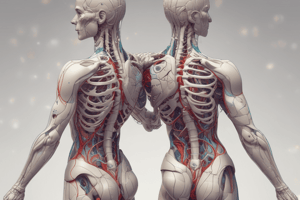Podcast
Questions and Answers
From which two sources does the liver receive blood?
From which two sources does the liver receive blood?
- Hepatic artery and Gastric vein
- Gastric vein and Hepatic portal vein
- Hepatic artery and Hepatic portal vein (correct)
- Splenic artery and Hepatic vein
In which part of the kidney are the collecting ducts located?
In which part of the kidney are the collecting ducts located?
- Nephron
- Renal cortex
- Renal medulla
- Renal pelvis (correct)
Which hormone is secreted by the hypothalamus to promote water reabsorption when blood pressure decreases?
Which hormone is secreted by the hypothalamus to promote water reabsorption when blood pressure decreases?
- Antidiuretic hormone (correct)
- Atrial natriuretic peptide
- Aldosterone
- Renin
Which hormone primarily stimulates ovulation?
Which hormone primarily stimulates ovulation?
Which hormone is notably elevated during pregnancy?
Which hormone is notably elevated during pregnancy?
Which valve is located between the right atrium and the right ventricle?
Which valve is located between the right atrium and the right ventricle?
Which valves are closed during ventricular systole?
Which valves are closed during ventricular systole?
Flashcards
Blood supply to liver
Blood supply to liver
The liver receives about 1.5 quarts of blood per minute from the hepatic artery and hepatic portal vein.
Collecting ducts location
Collecting ducts location
Collecting ducts are found in the renal pelvis of the kidney.
Antidiuretic hormone (ADH) function
Antidiuretic hormone (ADH) function
ADH is secreted by the hypothalamus when blood pressure decreases to promote water reabsorption.
Function of Luteinizing Hormone (LH)
Function of Luteinizing Hormone (LH)
Signup and view all the flashcards
Hormone during pregnancy
Hormone during pregnancy
Signup and view all the flashcards
Tricuspid valve location
Tricuspid valve location
Signup and view all the flashcards
Cell membrane characteristic
Cell membrane characteristic
Signup and view all the flashcards
Study Notes
Blood Supply to the Liver
- The liver receives approximately 1.5 quarts of blood per minute from the hepatic artery and hepatic portal vein.
Kidney Collecting Ducts
- Collecting ducts are found in the renal pelvis of the kidney.
Renal Hormone and Blood Pressure
- Antidiuretic hormone (ADH) is secreted by the hypothalamus when blood pressure decreases to promote water reabsorption.
Ovulation Stimulating Hormone
- Luteinizing Hormone (LH) stimulates ovulation.
Pregnancy Hormones
- Human Chorionic Gonadotropin (HCG) is elevated during pregnancy.
Heart Valves
- The tricuspid valve is located between the right atrium and the right ventricle.
- During ventricular systole, the atrioventricular valves are closed.
Cardiac Output and Blood Pressure
- When cardiac output increases, blood pressure increases.
Spinal Nerves
- Spinal nerves carry mixed information (both sensory and motor).
Body Temperature Regulation in Water
- Water has a higher heat capacity than air, causing a person to lose body temperature faster in water than in air.
Cell Membrane Properties
- The cell membrane is selectively permeable.
Cellular Respiration Substrate
- Glucose is broken down during cellular respiration.
Membrane Lining Body Cavities
- Serous membranes line body cavities and cover organs within those cavities.
Muscle Tissue Types
- Cardiac muscle has interlocking cells for efficient contraction.
Studying That Suits You
Use AI to generate personalized quizzes and flashcards to suit your learning preferences.




